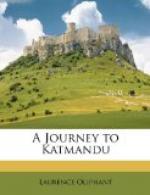In close vicinity to this temple is a mosque built by Arungzebe to annoy the Hindoos. I ascended the Maido Rai Minar or minaret, and from its giddy height had a magnificent panorama of the city and its environs, with the Ganges flowing majestically beneath, its left bank teeming with life, while the opposite bank seemed desolate.
The observatory, or man mundil, is on the river’s bank, and affords a pretty view from its terraces, which are covered with disks and semicircles and magical figures cut in stone.
Gopenate Dore Peshad is the great dealer in Benares embroidery, as well as its manufacturer. We paid him a visit and were delighted with the rich variety of embroidered goods which were displayed; we saw pieces valued at from 10,000 rupees downwards: magnificent smoking carpets, housings and trappings for horses, shawls, caps, kenkabs, and other articles of eastern attire, were spread out before us in gorgeous profusion. After eating a cardamum, and touching with our pocket-handkerchief some cotton on which had been dropped otto of roses, we ascended to the house-top, and found it built upon much the same plan as Cashmere Mull’s, without its antique carving and quaint appearance.
We were not a little glad when the bustle and heat attendant on so much sight-seeing was over, and we forced our way back through the crowded streets.
The population of Benares is estimated by Mr. Prinsep at nearly 200,000; its trade consists chiefly in sugar, saltpetre, indigo, opium, and embroidered cloths; besides which, the city has advantages in its position on the great river, making it, jointly with Mirzapore, the depot for the commerce of the Dukkum and interior of Hindostan.
General Jung Bahadoor had reached Benares a few days before I arrived there, and I found him installed in a handsome house, the envy of all rajahs, the wonder of the natives, and the admiration of his own countrymen, some thousands of whom had come thus far to meet him. If he had been a lion in London, he was not less an object of interest at Benares—his house was always crowded with visitors of high degree, Indian and European; one old native rajah in particular was frequently to be seen in close conference with him; and the result was, that the Prime Minister of Nepaul became the husband of the second daughter of his Highness the ex-Rajah of Coorg. Upon the day following his nuptials my friend and I called upon him, and to our surprise he offered to present us to his newly wedded bride. We, of course, expressed our sense of the honour he was doing us; and had just reached the balcony, the stairs leading up to which were on the outside of the house, when our friend the bridegroom perceived his father-in-law, the Coorg rajah, coming in a most dignified manner down the approach. Like a schoolboy caught in the master’s orchard, he at once retreated and unceremoniously hurried us back—and just in time, for no doubt, if




